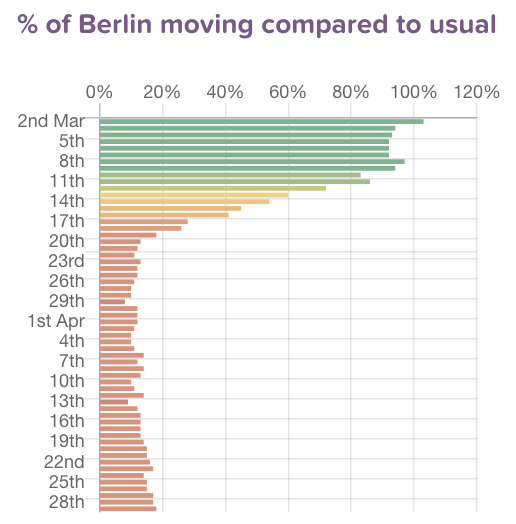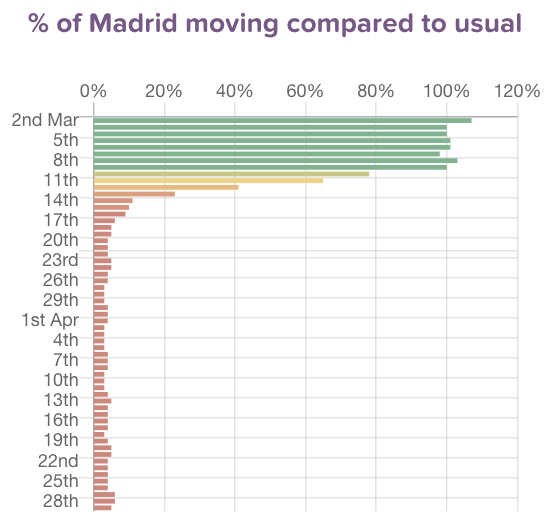🦠 COVID-19 | Vigilance on the plateau
I am a scientist by education, banker at JPMorgan for a few years, then mature PhD student in Chemical Biology at Oxford under the supervision of Christofer Schofield (FRS) and Peter Ratcliffe (Nobel laureate in medicine in 2019). Founder and tech investor focusing on media and education. I care about science, learning and Democracy which are good bedfellows.
📊 Daily Data Brief:
3,304,140 (+91,290) cumulative cases
Active cases: 2,031,256 (+44,193) (this is the number of currently infected patients)
Total Deaths: 233,829 (+6,049)
Serious/Critical Cases: 50,962 (-8,998)
Recovered: 1,039,055 (+41,048)
Source: Worldometers
Death curves (updated daily as ECDC releases). Major update with per country graphs now available (Link) (US, UK, France, Germany, Sweden) (👈NEW❗️)

As the first lockdowns enter their end phase, the news cycle will increasingly focus on drugs and vaccines, with a close-eye on case and fatality number trends as countries gradually re-open. Today we take a look at a brilliant and interactive explainer on vaccine development timeline and a summary on remdesivir studies.
We also show how South Korea’s preparedness and robust testing-tracing-isolating infrastructure got the country to reporting 0 home grown cases today without having as strict a lockdown as the ones which were put in place in other countries. An article on flying (including a chilling short video) post pandemic. Airplane design serves as another example of privileging efficiency over resilience in the travel industry with catastrophic consequences.
As the dust settles in emergency rooms in most part of the world, the psychological scars of this traumatic few weeks lead to the first reported suicide of two frontline healthcare workers in New York City.
Two great threads on the situation in the US and a Twitter review of a surprising serological survey. A video on why the US needs to build a “National Center for Epidemic Forecasting” and two podcasts on COVID-19 denialism and mental health inequalities.
💉Article of the day: Stuart Thompson writes “How Long Will a Vaccine Really Take?” for the New York Times.
The consensus about the vaccine in January was that it will be there in 12-18 months. Stuart Thompson starts off his article with a cold shower:
“The grim truth behind this rosy forecast is that a vaccine probably won’t arrive any time soon. Clinical trials almost never succeed. We’ve never released a coronavirus vaccine for humans before. Our record for developing an entirely new vaccine is at least four years — more time than the public or the economy can tolerate social-distancing orders.”
But then through clever interactive visualisation, Thompson takes the reader through the different stages of vaccine development (research, pre-clinical, Phase 1-3 trials, building factories, manufacturing, approval, distribution) and shows how we could shorten each phase and go from a typical date of May 2036 to a goal of August 2021.
A very informative read on what it will take for COVID-19 to be the fastest developed vaccine programme ever. (Link)
🇰🇷 Tweets of the day: on the benefit of robust tracing-testing infrastructure.
Today South Korea reported 4 cases, all of which were diagnosed at the airport. 0 home grown cases for a country with a population of 51 million people (Tweet 1). If you look at the CityMapper mobility index for Seoul relative to cities around the world, it remains at 40% of expected mobility whereas some other cities have had to reduce mobility to levels <10% through strict lockdown measures (Tweet 2).
How did South Korea do it: a state-of-the-art testing-tracing-isolating infrastructure which all countries looking to exit lockdown are looking to as a reference.
Tweet 1:

Tweet 2:





🧮 Video of the day: Dylan George is advocating for a National Center for Epidemic Forecasting. Even though we are not past the first wave, this should be funded and in place ahead of a potential second wave in the fall. We should also remember that Bill Gates called COVID-19 Pandemic I. (Link)


🇮🇹 Alberto Nardelli writes “Italy Was Once The Epicentre Of The Coronavirus. But A Report Says It’s Far Too Early To Lift Lockdown Restrictions” for BuzzFeed. As Angela Merkel explained to her citizen previously, Nardelli also reports that lifting all restrictions in Italy would result in overwhelming ICU capacity within a month (according to the epidemiological model used by the Italian government).
The country, and others around Europe, will have to thread carefully in their re-opening strategy so as not to waste the outcome of the strict lockdowns they have just gone through. The re-opening will involve continuing physical distancing measures, and resuming most activities with the exception of large gatherings and bars and restaurants outings. This is what the epidemiologists believe will be necessary to keep the transmission rate (R) of the virus at 1 or below.
These measures will be reviewed every 14 days based on whether R remains below 1. The plan also assumes that mask wearing is part of the measures and will account according to the assumptions for a 25% reduction of transmission.
The article also goes through what to expect or is currently underway in other european countries. We will be walking a ‘tightrope” as I previously titled an earlier edition of the Corona Daily. (Link)
🇺🇸 Trevor Bedford (FredHutch, Seattle) writes “The Long Plateau” Twitter thread. Bedford also looks at the current state and expected trend of the epidemic in the US. He starts by asking why we are talking about the second wave, when we have not yet finished riding the first one.
Bedford estimates that COVID-19 transmission rate is currently at around one and not decreasing. This is why we are observing a near constant 30,000 new reported cases per day and observing a ‘plateau’. At this rate and making the rather strong assumption that only 1 in 10 cases get reported Bedford predicts that 15% of the population would be infected by September 1. This would still be a far cry from the level of 55% needed to achieve herd immunity. (1st Tweet and Thread)
😰 Wendy Dean writes “Suicides of two health care workers hint at the Covid-19 mental health crisis to come” for STAT news. Dean reports the suicide of two health care workers in New York City: an emergency medical technician and an emergency physician.
The emotional and psychological scars that this pandemic will mark on the whole population and in particular the healthcare workers is unprecedented. These two suicides highlight the current deficiency in our mental health infrastructure. Not only have societies failed healthcare workers with personal protection equipment, but also with mental health protection and psychological support. The situation is even more under reported and acknowledged for nurses.
There is urgency to provide support during this first phase and to start investing in providing the support which will avoid regrettable deaths by suicide of our healthcare workers in the future. (Link)
✈️ Michael Laris writes “Scientists know ways to help stop viruses from spreading on airplanes. They’re too late for this pandemic.” in the Washington Post. There is a chilling video in the article of how the droplet of a coughing passenger circulates within an airplane cabin.
The same way the Diamond Princess has scarred for the foreseeable future the attractiveness of a cruise holiday, the current article shows how little thinking and investment has been made in planes to minimise disease transmission. Research is underway for the plane of the future. In a further example of designing our whole society for efficiency rather than resilience, Laris writes:
“But fighting illnesses and preparing for disaster were not the industry’s top priorities as global air travel soared.
“When you can easily sell your airplanes, you try to defer the problems to the future,” said Qingyan Chen, a Purdue University engineering professor who helped lead a major FAA-funded research project on disease transmission aboard aircraft and has received research funding from Boeing. “Today we found that future is actually 2020.” (my emphasis)
It is rather likely that compulsory mask wearing will be imposed by companies until new design and cabin improvement are implemented. Jet Blue has started by making mask wearing compulsory from May 4.
An interesting area to watch, and see how a financially decimated airline industry will voluntary take up the challenge to upgrade its fleet or be regulated to do so. (Link)
🇩🇰 Carl T. Bergstrom writes a Twitter thread dissecting a serosurvey from Denmark which showing an intriguing low Infection Fatality Rate (IFR) for 17-69 years old. Another serological survey with puzzling results, like the Santa Clara serological survey previously dissected in the Corona Daily.
Bergstrom explains how, with help of other colleagues or other twitter user, he was able to understand the misleadingly low IFR number reported in the survey. Bergstrom has provided an invaluable service during this pandemic of calling out the most outlandish tweets, medium posts and in this case critically reviewing the result of a pre-print paper. Misinformation can be costly in the times of a pandemic.
This thread shows us how to question a publication which seems at odds with other results. It is in effect a peer-review process in action. It is also a reminder, that it is often a good approach to question or wait for this accelerated peer-review process to happen before liking or reposting a story we came across on twitter. This will avoid spreading false information or misleading headlines (as for this pre-print).
A very worthwhile read to learn how to objectively assess information which is Bergstrom specialty as an academic. (1st Tweet and Thread)
💊 Jon Cohen writes “Large trial yields strongest evidence yet that antiviral drug can help COVID-19 patients” for Science. The article is a needed and good summary of all the studies that have been published on remdesivir. It explains why the one from the National Institute of Allergy and Infectious Diseases (NIAID) which grabbed the headline yesterday matters more than previous ones published on the anti-viral:
“Other studies of remdesivir have produced mixed results, with some showing no benefits and others generating positive outcomes. But each, by design or default, did not have the power of the NIAID-sponsored trial.”
This NIAID study is hopefully the first positive one of many to come for remdesivir and other candidates as we wait for the vaccine. (Link)
🎬 Podcasts of the day:
🦠 The cost of denial: how COVID-19 denialism are using the HIV denialism playbook (12 min 40 sec) (Link)

🛑 Covid-19 Side Effects/ Episode 22: Dr Shikta Das and Dr Pratima Singh put a worrying spotlight on BAME (Black, Asian and Minority Ethnic) communities, mental health inequalities, and the emerging data (48 min) (Link)
📊 A picture is worth a thousand words: Global (🌎) and local (with relevant flag) visualisation and forecasting tool
🌎The Financial Times (NEW❗️visualisation) has a data tracking page which is in front of the paywall, looking at cases and fatality curves for selective countries and metropolitan areas/region. It is not as extensive as the Madlag link below, where you can see static as well as animated images for a greater number of individual countries. (Link)🇺🇸 The John Hopkins University resource center was the first one I used back in January they have now made available in their latest iteration a county by county dashboard in the US including information about health capacity, insurance coverage, ethnicity and age breakdown of the population (New York example below) (Link)

💊 The "Map of Hope" provides a geographical overview of planned, ongoing and completed clinical trials. It is put together with data from WHO Clinical Trials Search Portal by the Heidelberg Institute for Geoinformation technology. (Link)
🌍 MRC Centre for Global Infectious Disease Analysis started to publish weekly death estimates for countries (Link)
🇺🇸 The US Center for Disease Control and Surveillance (CDC) publishes “A Weekly Surveillance Summary of U.S. COVID-19 Activity” (Link)
Google has published a new website to “See how your community is moving around differently due to COVID-19”. They have a lot of data to do so… (Link)
🇺🇸Another valuable resource by Unacast ( a data company providing human mobility insights). Their “Social distancing scoreboard looks and compares (State by State and County by County), the change in mobility to prior to COVID19 (Link)
🌎 Country by Country Curves: This is a GitHub made by my friend Francois Lagunas. He has written a script to scrape deaths and number of cases in order to visualise the rate of growth on a logarithmic scale. Great resource (Link)
CityMapper has started to produce City Mobility Index to show how much a City is moving. This is a very good indicator of how well lockdowns are respected around the world: Barcelona (4% of city moving) at one end and St Petersburg at the other end (68% of city moving) for yesterday (Link)
🌎A great resource put together by Ben Kuhn and Yuri Vishnevsky. At a time when we need solidarity and cooperation, I prefer their subtitle “We need stronger measures, much faster” than their title. It’s a simulator on what case growth looks like depending on your community’s measures. Fantastic resource to stir communities and governments to action (Link)
🇩🇪 The COVID19 dashboard for Germany is one of the best around. (Link)
🌎A helpful guide by VOX of the “9 coronavirus pandemic charts everyone should see” (Link)
🌎Data and chart regularly updated by the Centre for the Mathematical Modelling of Infectious Diseases at the London School of Hygiene & Tropical Medicine. It maps the effective reproduction number (also known as R0) of COVID19. You want to get it below 1 as fast as possible to contain an epidemic. (Link to see charts and more data about your country)
🌎This is a great COVID19 Dashboard prepared by Andrzej Leszkiewicz. Andrzej has also written an introductory and explanatory blog for it (“Coronavirus disease (COVID-19) fatality rate: WHO and media vs logic and mathematics”). I particularly like the country comparison tab, which allows you to track and benchmark the curve of the epidemic (number of cases and deaths) in your country with that of another. Very well done and informative. (Link)
“Going Critical” by Kevin Simler is a detailed interacting essay talking about complex systems, the importance of understanding networks, modelling and how this applies to: memes, infectious diseases, herd immunity, wildfire, neutrons and culture. Must read (Link)
🏛 Notable tracking projects
💊“COVID-19 treatment and vaccine tracker”. This tracker contains an aggregation of publicly-available information from validated sourcesby the Milken Institute (Link)🏛Tariq Krim has started a COVID19 website tracking data about each government policy response to the pandemic (Link)
🏛Oxford COVID-19 Government Response Tracker (OxCGRT) was launched yesterday. Data is collected from public sources by a team of dozens of Oxford University students and staff from every part of the world. It also looks at stringency of the measures and plots stringency with case curves. A great initiative and resource (Link)
👩💻Mike Butcher (Editor at Large Techcrunch and founder of TechforUK), had refocused TechforUK on the fight against COVID19. It is a very effective hands-on team of volunteer. Do reach out to them. He has also teamed up with We are now working closely with the volunteers behind the “Coronavirus Tech Handbook”. (They are ‘cousins’ of ours who originally created the Electiontechhandbook). Volunteer collaboration at its best! (Link)
📰Cronycle resource:Cronycle has made available a number of open-access feeds on its website which I extensively use for the Corona Daily. The four first feeds are:
1. COVID-19 General (Link)
2. COVID-19 x Resilience (Link)
3. COVID-19 x HCQ/CQ (Link) (HydroxyChloroquine and Chloroquine)
4. Gig Economy x COVID-19 (Link)
5. Supply Chain x COVID-19 (Link)
Human Rights x COVID-19 (Link)



